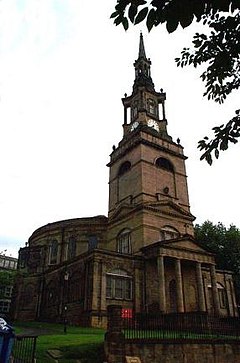All Saints' Church, Newcastle upon Tyne
| All Saints' Church | |
|---|---|
 |
|
| 54°58′12″N 1°36′25″W / 54.9699°N 1.6070°WCoordinates: 54°58′12″N 1°36′25″W / 54.9699°N 1.6070°W | |
| OS grid reference | NZ252639 |
| Location | Newcastle upon Tyne |
| Country | England |
| Denomination | Old Catholic |
| Architecture | |
| Status | Old Catholic Church |
| Functional status | Active |
All Saints' Church is a late 18th-century elliptical church in Lower Pilgrim Street, Newcastle upon Tyne, England, which replaced a medieval church on the same site. All Saints' Church is the third tallest religious building in Newcastle and the seventh tallest structure in the city overall. It is a Grade I listed building.
A Christian church stood here in 1286, and here continued to stand, of course undergoing many changes and restorations between times, until the end of the eighteenth century, when it was pulled down, and the present church built. The original All Saints', or All Hallows', was built in the Gothic style. Its appearance is thus described by Bourne:
“This church is seated upon a hill, which is much about the same height with the situation of St. Mary’s, in Gateshead, and upon the same line with it. It is not so long as St. Nicholas, being only 55 yards 1 foot a quarter long, but it is broader, as being 25 yards 2 feet broad. The steeple is but a mean height being a square tower, with only one spire arising from it. The bells belonging to this church were founded in 1696. They were cast out of the metal of that famous statue of King James the Second which stood on the Sandhill. They were founded in the ground belonging to St. Austin Friars, in that part of it which is in the back of the Hospital of the Holy Jesus. Their sound is not so melodious as the others in this town, but the note is exceedingly exact, and more tuneful than the others.”
McKenzie, who was living when the old church was pulled down, and when much public interest was taken in it, gives in his History an interesting account, from which we gather that the steeple and west end occupied the site of the present church. The church extended further east over what is now the burial ground. The steeple was a low, square, inelegant tower, supported by buttresses at the corners of the west side, and terminated by large embrasures. From the centre rose a small square turret, surmounted by a short spire, terminated with a gilt vane. The principal entrance into the church was the west door of the steeple which corresponded in size with the west door of St. Nicholas. Above it was a large and beautiful Gothic window. There were also a north and south porch, the former leading into Silver Street, the latter into Pilgrim Street. The steeple contained a good clock, with chimes and two painted dials. The five bells were cast by Christopher Hodgson of London. There were seven chantries; one of them – St Peter’s – being founded by Roger Thornton. The windows of the old church were large and ornamented with stained glass, but they were greatly damaged at the time of the civil war.
...
Wikipedia

